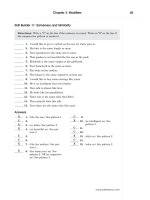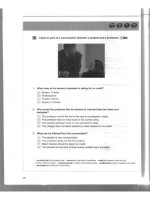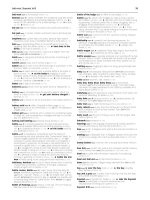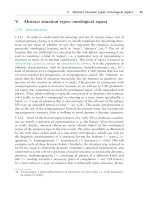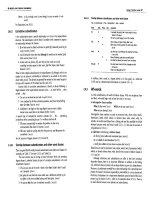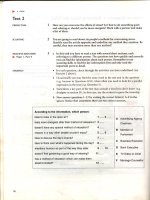BODY LANGUAGE - ALLAN PEASE Part 9 pot
Bạn đang xem bản rút gọn của tài liệu. Xem và tải ngay bản đầy đủ của tài liệu tại đây (234.92 KB, 15 trang )
achieve this objective, you feel that you will need to use direct questions that require
direct answers and may put the subordinate under pressure. At times you will also need
to show the subordinate that you understand his feelings and, from time to time, that
you agree with his thoughts or actions. How can you non-verbally convey these
attitudes using body formations? Leaving aside interview and questioning techniques
for these illustrations, consider the following points: (1) The fact that the counselling
session is in your office and that you are the boss allows you to move from behind your
desk to the employee’s side of the desk (the co-operative position) and still maintain
unspoken control. (2) The subordinate should be seated on a chair with fixed legs and
no arms, one that forces him to use body gestures and postures that will give you a
better understanding of his attitudes. (3) You should be sitting on a swivel chair with
arms, giving you more control and letting you eliminate some of your own giveaway
gestures by allowing you to move around.
There are three main angle formations that can be used.
Like the standing triangular position, the open triangular formation lends an
informal, relaxed attitude to the meeting and is a good position in which to open a
counselling session (Figure 147). You can show non-verbal agreement with the
subordinate from this position by copying his movements and gestures. As they do in
the standing position, both torsos point to a third mutual point to form a triangle; this
can show mutual agreement.
By turning your chair to point your body directly at your subordinate (Figure 148)
you are non-verbally telling him that you want direct answers to your questions.
Combine this position with the business gaze (Figure 149) and reduced body and facial
gestures and your subject will feel tremendous nonverbal pressure. If, for example,
after you have asked him a question, he rubs his eye and mouth and looks away when he
answers, swing your chair to point directly at him and say, ‘Are you sure about that?’
This simple movement exerts non-verbal pressure on him and can force him to tell the
truth.
When you position your body at a right angle away from your subject, you take the
pressure off the interview (Figure 149). This is an excellent position from which to ask
delicate or embarrassing questions, encouraging more open answers to your questions
without any pressure coming from you. If the nut you are trying to crack is a difficult
one, you may need to revert to the direct body point technique to get to the facts.
Summary
If you want a person to have rapport with you, use the triangular position and, when
you need to exert non-verbal pressure, use the direct body point. The right angle
position allows the other person to think and act independently, without non-verbal
pressure from you. Few people have ever considered the effect of body pointing in
influencing the attitudes and the responses of others.
These techniques take much practice to master but they can become ‘natural’ move-
ments before long. If you deal with others for a living, mastery of body point and swivel
chair techniques are very useful skills to acquire. In your day-to-day encounters with
others, foot pointing, body pointing and positive gesture clusters such as open arms,
visible palms, leaning forward, head tilting and smiling can make it easy for others not
only to enjoy your company, but to be influenced by your point of view.
Sixteen
Desks, Tables and Seating Arrangements
TABLE SEATING POSITIONS
Strategic positioning in relation to other people is an effective way to obtain co-
operation from them. Aspects of their attitude toward you can be revealed in the
position they take in relation to you.
Mark Knapp, in his book Non-Verbal Communication in Human Interaction, noted
that, although there is a general formula for interpretation of seating positions, the
environment may have an effect on the position chosen. Research conducted with white
middle-class Americans showed that seating positions in the public bar of an hotel can
vary from the seating positions taken in a high-class restaurant and that the direction in
which the seats are facing and the distance between tables can have a distorting
influence on seating behaviour. For example, intimate couples prefer to sit side by side
wherever possible, but in a crowded restaurant where the tables are close together this is
not possible and the couples are forced to sit opposite each other in what is normally a
defensive position.
Because of a wide range of moderating circumstances, the following examples
relate primarily to seating arrangements in an office environment with a standard
rectangular desk.
Person B can take four basic seating positions in relation to person A.
B1: The corner position
B2: The co-operative position
B3: The competitive-defensive position
B4: The independent position
The Corner Position (B1)
This position is normally used by people who are engaged in friendly, casual
conversation. The position allows for unlimited eye contact and the opportunity to use
numerous gestures and to observe the gestures of the other person. The corner of the
desk provides a partial barrier should one person begin to feel threatened, and this
position avoids territorial division on the top of the table. The most successful strategic
position from which a sales person can deliver a presentation to a new customer is by
position B1 assuming A is the buyer. By simply moving the chair to position B1 you
can relieve a tense atmosphere and increase the chances of a favourable negotiation.
The Co-operative Position (B2)
When two people are mutually oriented, that is, both thinking alike or working on a
task together, this position usually occurs. It is one of the most strategic positions for
presenting a case and having it accepted. The trick is, however, for B to be able to take
this position without A feeling as though his territory has been invaded. This is also a
highly successful position to take when a third party is introduced into the negotiation
by B, the sales person. Say, for example, that a sales person was having a second
interview with a client and the sales person introduced a technical expert. The
following strategy would be most suitable.
The technical expert is seated at position C opposite customer A. The sales person
can sit either at position B2 (co-operative) or B1 (corner). This allows the sales person
to be ‘on the client’s side’ and to question the technician on behalf of the client. This
position is often known as ‘siding with the opposition’.
The Competitive-Defensive Position (B3)
Sitting across the table from a person can create a defensive, competitive
atmosphere and can lead to each party taking a firm stand on his point of view because
the table becomes a solid barrier between both parties. This position is taken by people
who are either competing with each other or if one is reprimanding the other. It can also
establish that a superior/subordinate role exists when it is used in A’s office.
Argyle noted that an experiment conducted in a doctor’s office showed that the
presence or absence of a desk had a significant effect on whether a patient was at ease
or not. Only 10 per cent of the patients were perceived to be at ease when the doctor’s
desk was present and the doctor sat behind it. This figure increased to 55 per cent when
the desk was absent.
If B is seeking to persuade A, the competitive-defensive position reduces the
chance of a successful negotiation unless B is deliberately sitting opposite as part of a
pre-planned strategy. For example, it may be that A is a manager who must severely
reprimand employee B, and the competitive position can strengthen the reprimand. On
the other hand, it may be necessary for B to make A feel superior and so B deliberately
sits directly opposite A.
Whatever line of business you are in, if it involves dealing with people, you are in
the influencing business and your objective should always be to see the other person’s
point of view, to put him or her at ease and make him or her feel right about dealing
with you; the competitive position does not lead towards this end. More co-operation
will be gained from the corner and co-operative positions than will ever be achieved
from the competitive position. Conversations are shorter and more specific in this
position than from any other.
Whenever people sit directly opposite each other across a table, they unconsciously
divide it into two equal territories. Each claims half as his own territory and will reject
the other’s encroaching upon it. Two people seated competitively at a restaurant table
will mark their territorial boundaries with the salt, pepper, sugar bowl and napkins.
Here is a simple test that you can conduct at a restaurant which demonstrates how a
person will react to invasion of his territory. I recently took a salesman to lunch to offer
him a contract with our company. We sat at a small rectangular restaurant table which
was too small to allow me to take the comer position so I was forced to sit in the
competitive position.
The usual dining items were on the table: ashtray, salt and pepper shakers, napkins
and a menu. I picked up the menu, read it, and then pushed it across into the other man’s
territory. He picked it up, read it, and then placed it back in the centre of the table to his
right. I then picked it up again, read it, and placed it back in his territory. He had been
leaning forward at this point and this subtle invasion made him sit back. The ashtray
was in the middle of the table and, as I ashed my cigarette, I pushed it into his territory.
He then ashed his own cigarette and pushed the ashtray back to the centre of the table
once again. Again, quite casually, I ashed my cigarette and pushed the ashtray back to
his side. I then slowly pushed the sugar bowl from the middle to his side and he began
to show discomfort. Then I pushed the salt and pepper shakers across the centre line. By
this time, he was squirming around in his seat as though he was sitting on an ant’s nest
and a light film of sweat began to form on his brow. When I pushed the napkins across
to his side it was all too much and he excused himself and went to the toilet. On his
return, I also excused myself. When I returned to the table I found that all the table
items had been pushed back to the centre line!
This simple, effective game demonstrates the tremendous resistance that a person
has to the invasion of his territory. It should now be obvious why the competitive
seating arrangement should be avoided in any negotiation or discussion.
There will be occasions on which it may be difficult or inappropriate to take the
corner position to present your case. Let us assume that you have a visual presentation;
a book, quotation or sample to present to another person who is sitting behind a
rectangular desk. First, place the article on the table (Figure 155). The other person will
lean forward and look at it, take it into his territory or push it back into your territory.
If he leans forward to look at it, you must deliver your presentation from where you
sit as this action non-verbally tells you that he does not want you on his side of the desk.
If he takes it into his territory this gives you the opportunity to ask permission to enter
his territory and take either the corner or cooperative positions (Figure 157). If, how-
ever, he pushes it back, you’re in trouble! The golden rule is never to encroach on the
other person’s territory unless you have been given verbal or non-verbal permission to
do so or you will put them offside.
The Independent Position (B4)
This is the position taken by people when they do not wish to interact with each
other; it occurs in such places as a library, park bench or restaurant. It signifies lack of
interest and can even be interpreted as hostile by the other person if the territorial
boundaries are invaded. This ‘position should be avoided where open discussion
between A and B is required.
SQUARE, ROUND, RECTANGULAR TABLES
Square Table (Formal)
As previously mentioned, square tables create a competitive or defensive
relationship between people of equal status. Square tables are ideal for having short,
to-the-point conversations or to create a superior/subordinate relationship. The most
co-operation usually comes from the person seated beside you and the one on the right
tends to be more co-operative than the one on the left. The most resistance usually
comes from the person seated directly opposite.
Round Table (Informal)
King Arthur used the Round Table as an attempt to give each of his knights an equal
amount of authority and status. A round table creates an atmosphere of relaxed in-
formality and is ideal for promoting discussion among people who are of equal status as
each person can claim the same amount of table territory. Removing the table and
sitting in a circle also promotes the same result. Unfortunately, King Arthur was un-
aware that if the status of one person is higher than the others in the group it alters the
power and authority of each other individual. The king held the most power at the
Round Table and this meant that the knights seated on either side of him were
non-verbally granted the next highest amount of power, the one on his right having a
little more than the one on the left, and the amount of power diminished relative to the
distance that each knight was seated away from the king.
Consequently, the knight seated directly across the table from King Arthur was, in
effect, in the competitive-defensive position and was likely to be the one who gave the
most trouble. Many of today’s business executives use both square and round tables.
The square desk, which is usually the work desk, is used for business activity, brief con-
versations, reprimands and the like. The round table, often a coffee table with wrap-
around seating, is used to create an informal relaxed atmosphere or to persuade.
Rectangular Tables
On a rectangular table, position A has always commanded the most influence. In a
meeting of people of equal status the person sitting at position A will have the most
influence, assuming that he does not have his back to the door. If A’s back were facing
the door, the person seated at B would be the most influential and would be strong
competition for A. Assuming that A was in the best power position, person B has the
next most authority, then C, then D. This information makes it possible to structure
power plays at meetings by placing name badges on the seats where you want each
person to sit so that you may have the maximum influence over them.
The Dining Table at Home
The choice of the shape of a family dining room table can give a clue to the power
distribution in that family, assuming that the dining-room could have accommodated a
table of any shape and that the table shape was selected after considerable thought.
‘Open’ families go for round tables, ‘closed’ families select square tables and
‘authoritative’ types select rectangular tables.
GETTING A DECISION OVER DINNER
Bearing in mind what has already been said about human territories and the use of
square, rectangular and round tables, let us now look at the dynamics of taking a person
to dinner where the objective is to obtain a favourable response to a proposition. Let us
examine the factors that can build a positive atmosphere, discuss their origin and
potential and examine the background of man’s feeding behaviour.
Anthropologists tell us that man’s origin was that of a tree-dweller who was strictly
vegetarian, his diet consisting of roots, leaves, berries, fruit and the like. About a
million years ago, he came out of the trees onto the plains to become a hunter of prey.
Prior to his becoming a land dweller, man’s eating habits were those of the monkeys -
involving continual nibbling throughout the day. Each individual was entirely
responsible for his own survival and for obtaining his own food. As a hunter, however,
he needed the co-operation of other individuals to capture large prey, so large
co-operative hunting groups were formed. Each group would leave at sunrise to hunt
throughout the day and return at dusk with the day’s spoils. These were then divided
equally among the hunters, who would eat inside a communal cave.
At the entrance to the cave a fire was lit to ward off dangerous animals and to
provide warmth. Each caveman sat with his back against the wall of the cave to avoid
the possibility of being attacked from behind while he was engrossed in eating his meal.
The only sounds that were heard were the gnashing and gnawing of teeth and the
crackle of the fire. This ancient process of food sharing at dusk around an open fire was
the beginning of a social event that modern man re-enacts in the form of barbecues,
cookouts and dinner parties. Modern man also reacts and behaves at these events in
much the same way as he did over a million years ago.
Now to our restaurant or dinner party. A positive decision in your favour is easier to
obtain when your prospect is relaxed, free of tension and his or her defensive barriers
have been lowered. To achieve this end, and keeping in mind what has already been
said about our ancestors, a few simple rules need to be followed.
First, whether you are dining at your home or at a restaurant, have your prospect
seated with his back to a solid wall or screen. Research shows that respiration, heart rate,
brain wave frequencies and blood pressure rapidly increase when a person sits with his
back to an open space, particularly where others are moving about. Tension is further
increased if the person’s back is towards an open door or a window at ground level.
Next, the lights should be dimmed and muffled background music played. Many top
restaurants have an open fireplace or facsimile near the entrance of the restaurant to
recreate the fire that burned at the ancient cave feasts. It would be best to use a round
table and to have your prospect’s view of other people obscured by a screen or large
green plant if you are to have a captive audience.
It is far easier to obtain a favourable decision under these circumstances than it will
ever be in restaurants that have bright lighting, tables and chairs placed in open areas
and the banging of plates, knives and forks. Top restaurants use these types of
relaxation techniques to extract large amounts of money from their customer’s wallets
for ordinary food, and men have been using them for thousands of years to create a
romantic atmosphere for the benefit of their women.
Seventeen
Power Plays
POWER PLAYS WITH CHAIRS
Have you ever been for a job interview and felt overwhelmed or helpless when you
sat in the visitor’s chair? Where the interviewer seemed so big and overwhelming and
you felt small and insignificant? It is likely that the interviewer had cunningly arranged
his office furnishings to raise his own status and power and, in so doing, to lower yours.
Certain strategies using chairs and seating arrangements can create this atmosphere in
an office.
The factors involved in raising status and power by using chairs are: the size of the
chair and its accessories, the height of the chair from the floor and the location of the
chair relative to the other person.
Chair Size and Accessories
The height of the back of the chair raises or lowers a person’s status and the
high-backed chair is a well-known example. The higher the back of the chair, the
greater the power and status of the person sitting in it. Kings, queens, popes and other
high-status people may have the back of their throne or official chair as high as 250
centimetres (over 8 feet) to show their status relative to their subjects; the senior
executive has a high-backed leather chair and his visitor’s chair has a low back.
Swivel chairs have more power and status than fixed chairs, allowing the user
freedom of movement when he is placed under pressure. Fixed chairs allow little or no
movement and this lack of movement is compensated by body gestures that can reveal a
person’s attitudes and feelings. Chairs with arm rests, those that lean back and those
that have wheels are better than chairs that have not.
Chair Height
The acquisition of power using height was covered in Chapter 14 but it is worth
noting that status is gained if your chair is adjusted higher off the floor than the other
person’s. Some advertising executives are known for sitting on high-backed chairs that
are adjusted for maximum height while their visitors sit opposite, in the competitive
position, on a sofa or chair that is so low that their eyes are level with the executive’s
desk (Figure 162). A common ploy is to have the ashtray just out of the visitor’s reach,
which forces him to be inconvenienced when ashing his cigarette.
Chair Location
As mentioned in the chapter on seating arrangements, the most power is exerted on
the visitor when his chair is placed in the competitive position. A common power play
is to place the visitor’s chair as far away as possible from the executive’s desk into the
social or public territory zone, which further reduces the visitor’s status.
STRATEGIC OFFICE LAYOUT
Having read this book, you should now be able to arrange your office furniture in
such a way as to have as much power, status or control over others as you wish. Here is
a case study showing how we rearranged a person’s office to help solve some of his
supervisor/ employee relationship problems.
John, who was an employee in an insurance company, had been promoted to a
manager’s position and was given an office. After a few months in the role, John found
that the other employees disliked dealing with him and his relationship with them was
occasionally hostile, particularly when they were in his office. He found it difficult to
get them to follow his instructions and guidance and he heard that they were talking
about him behind his back. Our observations of John’s plight revealed that the
communication breakdowns were at their worst when the employees were in his office.
For the purpose of this exercise, we will ignore management skills and concentrate
on the non-verbal aspects of the problem. Here is a summary of our observations and
conclusions about John’s office layout.
1. The visitor’s chair was placed in the competitive position in relation to John.
2. The walls of the office were timber panels except for an outside window and a
clear glass partition that looked into the general office area. This glass partition reduced
John’s status and could increase the power of a subordinate who was sitting in the
visitor’s chair because the other employees were directly behind him and could see
what was happening.
3. John’s desk had a solid front that hid the lower part of his body and prevented the
subordinates observing many of John’s gestures.
4. The visitor’s chair was placed so that the visitor’s back was to the open door.
5. John often sat in the both-hands-behind-head position (Figure 96) and in the
leg-over-chair position (Figure 132) whenever a subordinate was in his office.
6. John had a swivel chair with a high back, arm rests and wheels. The visitor’s
chair was a plain low-backed chair with fixed legs and no arm rests.
Considering that between 60 and 80 per cent of human communication is done non-
verbally, it is obvious that these aspects of John’s non-verbal communication spelt
disaster. To rectify the problem the following rearrangements were made.
1. John’s desk was placed in front of the glass partition, making his office appear
bigger and allowing him to be visible to those who entered his office.
2. The ‘hot seat’ was placed in the comer position, making communication more
open and allowing the corner to act as a partial barrier when necessary.
3. The glass partition was sprayed with a mirror finish, allowing John to see out, but
not permitting others to see in. This raised John’s status and created a more intimate
atmosphere within his office.
4. A round coffee table with three identical swivel chairs was placed at the other end
of the office to allow informal meetings to take place on an equal level.
5. In the original layout (Figure 163), John’s desk gave half the table territory to the
visitor and the revised layout (Figure 164) gave John complete claim to the desk top.
6. John practised relaxed open arms and legs gestures combined with frequent palm
gestures when speaking with subordinates in his office.
The result was that supervisor/employee relationships improved and the employees
began describing John as an easygoing and relaxed supervisor.
STATUS RAISERS
Certain objects strategically placed around the office can be subtly used
non-verbally to increase the status and power of the occupant. Some examples include:
1. Low sofas for visitors to sit on.
2. A telephone with a lock on it.
3. An expensive ashtray placed out of the reach of the visitor, causing him
inconvenience when ashing his cigarette.
4. A cigarette container from overseas.
5. Some red folders left on the desk marked ‘Strictly Confidential’.
6. A wall covered with photos, awards or qualifications that the occupant has
received.
7. A slim briefcase with a combination lock. Large, bulky briefcases are carried by
those who do all the work.
All that is needed to raise your status, increase your power and effectiveness with
others is a little thought given to non-verbal gymnastics in your office or home. Un-
fortunately, most executive offices are arranged like the one in Figure 163; rarely is
consideration given to the negative non-verbal signals that are unwittingly
communicated to others.
We suggest that you study your own office layout and use the preceding
information to make the positive changes needed.
